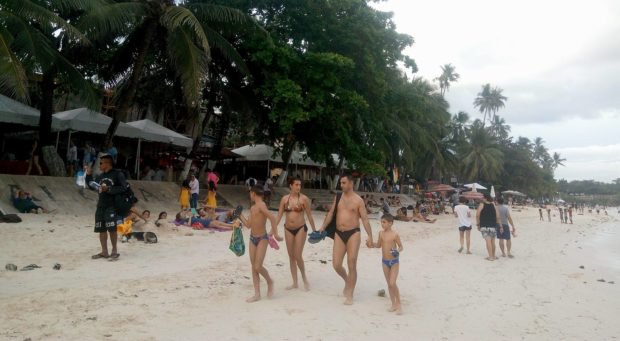
ENVIRONMENTAL WOES Like Boracay, Panglao Island, Bohol’s tourism jewel, is suffering from environmental problems because of unregulated development, lax enforcement of laws, and continued surge in tourist arrivals. — Inquirer.net / LEO UDTOHAN
PANGLAO, Bohol — After Boracay, another island in the Visayas could be the next target of President Rodrigo Duterte after he was told that it was teeming with resorts with no septic tanks and proper waste disposal facilities.
Socioeconomic Planning Secretary Ernesto Pernia, a Boholano, told the Inquirer on Monday that Mr. Duterte planned to shut down the erring resorts on Panglao Island in Bohol province if these violations were not corrected.
Pernia said Panglao was suffering from environmental problems because of unregulated development, lax enforcement of laws, and continued surge in tourist arrivals.
“It could be next if violators would not correct their mistakes by complying with environmental laws and regulations,” he said in a phone interview. “It’s a warning to save the country’s prime tourist destinations from further environmental destruction.”
Pernia, who heads the National Economic and Development Authority, said local officials could prevent Panglao from becoming another Boracay by enforcing environmental laws.
Panglao, which is composed of Dauis and Panglao towns, is Bohol’s tourism jewel. But it has been facing environmental concerns over the past years.
Resort owners construct illegal structures in restricted zones and managing wastewater is among the critical concerns of the island, as it has no sewerage system and wastewater facility.
In an interview over radio station dzRD’s “Inyong Alagad” on Friday, Pernia expressed disappointment that such environmental violations were tolerated by local officials, both in the provincial and municipal levels.
Mr. Duterte has issued a six-month deadline for government agencies, local government units and business operators to address Boracay’s environmental problems.
He called the popular tourist destination a “cesspool” and “full of shit” and threatened to close down the 1,032-hectare island.
Pernia said that to avoid closure, erring resort owners in Panglao should follow the law.
33 have EMB permit
There are at least 200 commercial establishments operating in Panglao town, but only 33 establishments have permits from the Environmental Management Bureau (EMB), an agency attached to the Department of Environment and Natural Resources.
Panglao Councilor Rogelyn Clemeña-Degoma pointed out that most establishments in Panglao had no wastewater treatment facility.
On Jan. 4, the EMB presented results of tests made by its ambient monitoring station on the water quality of Alona Beach in the village of Tawala.
The tests found that the level of fecal coliform continued to spike and breach acceptable levels.
The EMB report showed levels of fecal coliform bacteria exceeding DENR standards for recreational water.
According to the test results, total fecal coliform in the area was 305.70 most probable number (MPN) per 100 milliliters, way above the acceptable level of 100 MPN per 100 ml. Fecal coliform bacteria come from human and animal feces.
The EMB, however, assured tourists that overall water quality in Panglao was within acceptable standards, especially for swimming and water sports activities.
Bohol needs to strengthen its tourism potential by moving back the illegal structures on the beaches, especially along the Alona stretch, Degoma said.
Eye opener
She said Boracay’s case was a lesson and an eye opener for all local officials in Bohol.
“By this time, we will strictly implement the requirement for the discharge permit of businesses and the implementation of building structures within the 20-meter salvage [or easement] zone,” the councilor said.
Municipal workers will be assigned to monitor the cleanliness of the beaches.
“We will be negotiating partnerships with private individuals for a water treatment and sewerage treatment facility,” Degoma said.
Cindylyn Pepito of EMB’s Ambient Quality Monitoring Section said a massive cleanup would be held on March 6 to save Panglao Island.
“We still have the opportunity to correct bad practices,” Pepito said.

